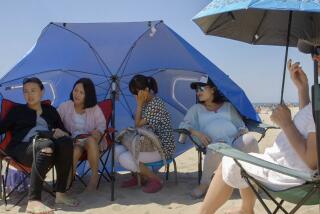Teacher Gives Pregnancy a Breather
LEUCADIA — On Jan. 5, when Patty and Jeff Anstett rushed down to UC San Diego Medical Center for the birth of their first child, they weren’t prepared to become parents quite so soon. Patty had gone into labor five weeks early.
But they had prepared themselves for childbirth, by studying the Bradley Method.
“We were very pleased with it,” said Patty Anstett, adding that she went through her 5 1/2-hour labor with her husband close to her, providing loving encouragement. She also managed without any medication.
Four evenings later, in a house on a quiet street in Leucadia, Isobel Hazelhurst--a registered nurse who was the Anstetts’ childbirth educator--talked about the Bradley Method as she got ready to teach a class.
“People are always asking me what the difference is between Bradley and Lamaze,” she said. One of the main differences, she explained, is in the breathing.
“Lamaze breathing focuses on distracting the mind from the pain of labor contractions. The focus is outside the body. The mother’s eyes are open. In Bradley the mother is trained in abdominal breathing. Her eyes are closed, and the focus is inside the body--flowing and relaxing with the pain, as you’d relax with an ocean wave to let it carry you to shore.”
Propped above the large stone fireplace in Hazelhurst’s living room was a hand-lettered sign that read:
PATTY AND JEFF ANSTETT HAD A GIRL ON MONDAY. ALYCIA NICOLE. 5 LBS. MOM AND BABY ARE GREAT.
“This is the sixth class in a series of 10,” she said. “All the couples who come are interested in learning about the experiences of the others. It could be their turn next.”
The front door opened, letting in a draft of chilly air and a couple clutching pillows. They were followed by five more pillow-clutching couples and one unaccompanied expectant mother-- Dutch-born Marga Yolles--who had come by herself because her husband was away on business.
There was a lot of laughter while everyone got settled. It’s a friendly class. All of the mothers were somewhere in the last two months of their pregnancies. Seven growing bumps protruded under an assortment of loose maternity sweaters and T-shirts.
Hazelhurst, 31, was a public health nurse until she had a child two years ago. She has been teaching Bradley classes for almost five years. Most of her students, she says, are of her own generation. Their ages usually range from the late 20s to the mid-30s.
“Because the Bradley Method isn’t as well-known as Lamaze--and for this reason couples have to actively track down a Bradley class--I get a lot in their mid-30s who have read everything about childbirth they can find.”
Marilyn and Don Weinhouse, she said, indicating a couple who were lounging comfortably on her carpet, are this kind of couple. Both of them are schoolteachers.
“We were married for 10 years before we decided to have a child,” Don said. “I’ve worked with both handicapped and gifted children. It impressed on me the responsibility you take on when you choose to become a parent.”
The video Hazelhurst was showing that evening was on the benefits of giving birth upright. It was made by a Venezuelan obstetrician, Eva Gundberg, whom she met at a prenatal psychology conference.
“It shortens the process of deliveries, because of the aid of gravity,” she explained as the class watched a beautiful young woman deliver a baby while standing. The woman’s knees were slightly bent. Her husband supported her weight from behind, while the doctors stayed in front of her to guide the baby as he slid into the world.
“That seemed to go pretty smoothly,” Rick Reeder of Oceanside murmured to his wife, Melissa.
Melissa Reeder was planning to try the supported standing position when she has her baby at the Alternative Birthing Center (known as the ABC room) at Mercy Hospital.
“I tried the squatting position when our daughter was born 2 1/2 years ago,” Reeder, now a Bradley student for the second time, recalled. “It worked fine. But it was a little hard on the legs!”
“The key is to deliver in whatever position feels good to you ,” Hazelhurst said. “To trust your body. It’s very important to have an understanding with your doctor about this.”
Doctors and nurses, as Hazelhurst well remembers from her own experiences, are as human as anybody else. They get tired. They have certain ways of doing things. Hospitals, too, have rules.
Dr. Robert Bradley’s credo of “It’s not nice to fool Mother Nature, and if you do you’ll wish you hadn’t,” runs contrary to some hospitals’ standard obstetrical practices.
“So be clear. Let your doctor know if you plan to walk around during your labor. Tell him or her that you want to deliver your baby in whatever position works for your body,” Hazelhurst urged the mothers in her class. (She herself spent part of the second stage of her labor standing under a warm shower, because it felt so good.)
“And if your doctor has a problem with that, then find one who is more understanding. One you feel comfortable with. You are the consumer.”
The hardest position from which to push out a baby, Hazelhurst said--one in which the woman gets little help from either gravity or her own muscular system--is the classic flat-on-the-back with legs-up-in-stirrups.
“That’s the position a British journalist once nicknamed ‘the stranded beetle.’ ”
Bradley classes are always small. And personal. A Bradley childbirth educator has to get written permission to have more than eight couples in a class. Hazelhurst has found seven couples to be the ideal number.
“Let’s do a little bit of labor practice,” she suggested as she beckoned to Marga Yolles. As Yolles curled on her side, her baby moved, stirring the front of her coral pink maternity sweater. Hazelhurst bent over her, playing the role of a father, stroking her back, whispering soothing words to encourage relaxation.
“Men have a tendency to speak loudly and rub hard,” she said, smiling. “Maybe it’s because most of them like a hard massage themselves. But this is the time for tenderness.”
In a 1984 article, written by Leah Yarrow for Parents magazine, Bradley is quoted as urging fathers to relax their wives by actually courting them during the early stages of labor.
“Whatever he gave her in the moonlight, originally, we tell him to do it now,” Bradley said. “That varies from plucking a guitar to reciting poetry to describing a trip they shared. It helps the mother not to tense up when her uterus tenses up.”
In the first stage of labor, Hazelhurst said, women often get so relaxed they fall asleep.
In the second stage, Hazelhurst told the fathers in the class, the woman sometimes doesn’t feel like being stroked or touched. She may even yell at the man.
“But don’t take it personally! Just stay close to her. Your presence alone makes a difference.”
At 8 p.m., halfway through the three-hour class, the group took a break, wandering into Hazelhurst’s dining room for a snack of fresh melon slices. An entire wall of the dining room was covered with photographs of Bradley graduates and their babies.
“We always have a reunion pot-luck supper. About three weeks after the last baby comes out,” she said, making them sound like debutantes going to a ball.
“It’s a joyous occasion. The women dress up--usually none of the group have seen them before without that huge tummy. We line all the babies up on the sofa. They’re a lot noisier than they were in the classes!”
“Gary and I were really disappointed when the class ended. You miss socializing with other couples at the same stage,” Karen Wienokly said.
Wienokly, a former nurse at the San Diego Birth Center, took Bradley classes during all three of her pregnancies. She feels that Bradley, more than any other method of childbirth education, focuses on a man and a woman getting to know themselves as a couple.
“For us it did a great deal for our marriage. But learning to trust your body during labor--to go inside yourself mentally--takes a lot of practice,” said Wienokly, who had her last baby, an 8 pound, 7 ounce boy they named Skyler, in October.
“I find that the couples in the classes come back with a real need to share their birth experiences,” Hazelhurst said.
“When you have a baby most people will ask you if you had a boy or a girl. And how much did your baby weigh. But few people will ask you what your emotions were when you saw your baby’s head emerging. Anyone who has just had a baby has been through a natural drama.”
More to Read
Sign up for Essential California
The most important California stories and recommendations in your inbox every morning.
You may occasionally receive promotional content from the Los Angeles Times.










